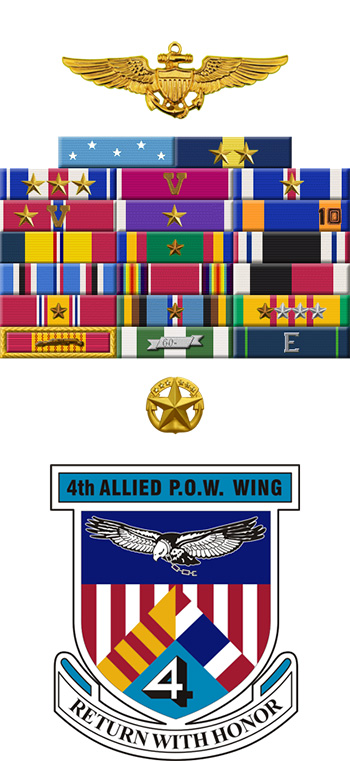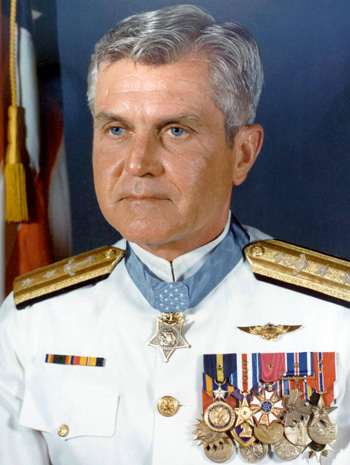
|
James B. Stockdale |
 |
|||
| Rank, Service | ||||
Vice Admiral O-9, U.S. Navy |
||||
| Veteran of: | ||||
|
||||
| Tribute: | ||||
Jim Stockdale was born on December 23, 1923, in Abingdon, Illinois. He entered the U.S. Naval Academy in June 1943, and was commissioned a year early due to World War II, on June 5, 1946. His first assignment was as an Assistant Gunnery Officer aboard the destroyer minesweeper USS Carmick (DMS-33) from June to October 1946, followed by service as Assistant Engineering Officer aboard the destroyer minesweeper USS Thompson (DMS-38) from October 1946 to February 1947. LTJG Stockdale next served as Communications Officer aboard the destroyer USS Charles H. Roan (DD-853) from February 1947 to July 1948, and then as Executive Officer aboard the patrol craft sweeper USS Deming (PCS-1392) from July 1948 to June 1949. He was accepted for flight training at NAS Pensacola, Florida, in June 1949, was designated a Naval Aviator at NAS Corpus Christi, Texas, in September 1950, and then completed additional training at the Fleet Airborne Electronics Training Unit at NAS Norfolk, Virginia, from October 1950 to January 1951. His first operational flying assignment was as a TBF Avenger and AF Guardian pilot with VS-27 at NAS Norfolk from January 1951 to January 1954, followed by Test Pilot training at NAS Patuxent River, Maryland, from January to July 1954. LT Stockdale served as a Project Test Pilot at Pax River from July 1954 to January 1957, and then served as an F8U Crusader pilot and Operations Officer with VF-211 at NAS Moffett Field, California, from January 1957 to March 1959, and then with VF-24 at NAS Moffett Field from March 1959 to August 1960. LCDR Stockdale attended Postgraduate School at Stanford University in Palo Alto, California, from September 1960 to September 1962, and then completed F-8 Replacement Air Group training with VF-124 at NAS Miramar, California, from September 1962 to February 1963. His next assignment was as Executive Officer of VF-51 at NAS Miramar from February to September 1963, and then as Commanding Officer of VF-51 from September 1963 to October 1964. During this time he flew combat missions in Southeast Asia during the opening days of the Vietnam War after the Gulf of Tonkin Incident. CDR Stockdale served as Operations Officer of CVW-12 from October 1964 to February 1965, and then as Commanding Officer of CVW-16 from February 1965 until he was forced to eject over North Vietnam and was taken as a Prisoner of War on September 9, 1965. After spending 2,714 days in captivity, Capt Stockdale was released during Operation Homecoming on February 12, 1973. He was briefly hospitalized to recover from his injuries at the Naval Hospital in San Diego, California, and then served as Commander of Anti-Submarine Warfare Wing, U.S. Pacific Fleet, from January 1974 to April 1976. ADM Stockdale next served in the Office of the Chief of Naval Operations as Deputy Director of Strategic Plans, Policy, Nuclear Systems at the Pentagon from April 1976 to October 1977, followed by service as President of the Naval War College at Newport, Rhode Island, from October 1977 until his retirement from the Navy on September 1, 1979. In 1992 Admiral Stockdale ran as Ross Perot's Vice Presidential Cadidate of the Reform Party. He died on July 5, 2005, and was buried at the U.S. Naval Academy Cemetery in Annapolis, Maryland. His Medal of Honor Citation reads: For conspicuous gallantry and intrepidity at the risk of his life above and beyond the call of duty while senior naval officer in the Prisoner of War camps of North Vietnam. Recognized by his captors as the leader in the Prisoners' of War resistance to interrogation and in their refusal to participate in propaganda exploitation, Rear Adm. Stockdale was singled out for interrogation and attendant torture after he was detected in a covert communications attempt. Sensing the start of another purge, and aware that his earlier efforts at self-disfiguration to dissuade his captors from exploiting him for propaganda purposes had resulted in cruel and agonizing punishment, Rear Adm. Stockdale resolved to make himself a symbol of resistance regardless of personal sacrifice. He deliberately inflicted a near-mortal wound to his person in order to convince his captors of his willingness to give up his life rather than capitulate. He was subsequently discovered and revived by the North Vietnamese who, convinced of his indomitable spirit, abated in their employment of excessive harassment and torture toward all of the Prisoners of War. By his heroic action, at great peril to himself, he earned the everlasting gratitude of his fellow prisoners and of his country. Rear Adm. Stockdale's valiant leadership and extraordinary courage in a hostile environment sustain and enhance the finest traditions of the U.S. Naval Service. |
||||
|
||||

